Twitter for SEO
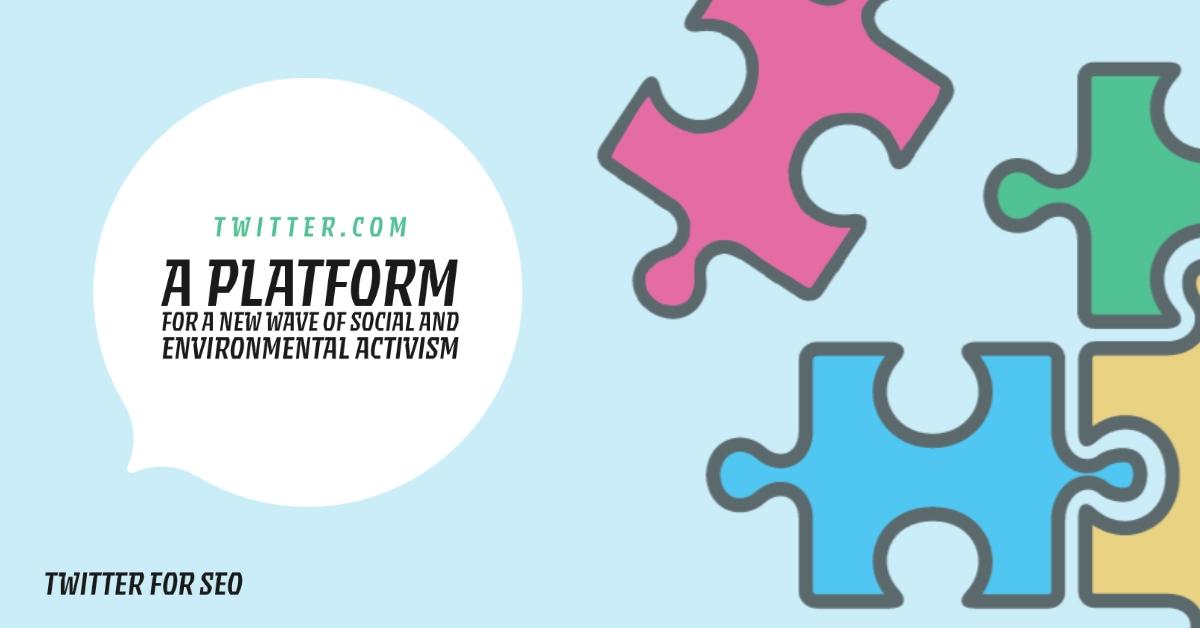
- May 3, 2022 modified: Jul, 24 2025
Twitter for SEO
Original article 3 May 2022 - Updated July 2025
How to Productively Use Twitter for SEO of your website in 2024 and beyond. This article covers how to use X (formerly Twitter) to enhance your website SEO. (Not the other way around). How to leverage Twitter to boost your search engine campaigns.
Twitter underwent a major overhall in 2022 - Twitter's Next Chapter: Insights into the X Rebrand. It still remains a major social media platform, with popularity in various countries and across demographics that some platforms are lagging. We focus on the value of using the now X platform for Search Engine Optimisation (SEO).
"Twitter has provided a platform for a new wave of social and environmental activism, and provides an opportunity for brands to do purpose-driven advertising."
Twitter describes itself on twitter.com as "a platform for a new wave of social and environmental activism". So how can an SEO (Search Engine Optimisation) best make use of this platform?
Using Twitter as an "Activist" to get the Network Effect
If Twitter is an "activist platform" and not merely about telling people what you had for breakfast (i.e.mundane self-referencing, self-promotional content), to gain the best SEO response from Twitter you need to use it as an activist would.
Twitter is often regarded as an "echo chamber" or to quote the late media mogul, Kerry Packer, "this is not a democracy son".
There is the opportunity to have "like minded" people endorse ( retweet, interact, like, quote, impression) your tweet. The network effect is generated by others viewing your tweet, and the ultimate goal of any tweet when it comes to SEO is to have someone retweet and interact (click) your tweet link .
For Twitter to generate the network effect with the aim of getting a large number of clicks, your followers are important. Other Twitter users who regularly follow and retweet your tweets are therefore very important. Hence reciprocating and rewarding (retweeting) good content by others makes sense.

Despite increased participation on X, women often face challenges in achieving comparable visibility and engagement to men.
Twitter "the ideal platform for bad discourse"
According to Dr Tim Dean philosopher and author of: How We Became Human - and why we need to change -:
"If you want to create a communications platform that was built for bad discourse, you could not do better than to build Twitter."
Dean maintains that Twitter's inadequacies are based on the following limitations:
- Only enough characters (280) for a conclusion
- Not enough characters for your argument (reasons)
- Reasons qualifications and evidence missing
In an ABC program All in the Mind How we make up our minds the following conversation snippets relating to Twitter and social media were analysed by Dean-:
Dr Tim Dean: The second thing is all of the reward mechanisms in not just Twitter but other kinds of social media. They're based around engagement, not quality. And there's a lot of evidence to show that if you post a tweet with a lot of emotion and mobilize outrage and disgust you get more ‘likes’, you'll get more shares than you will if you post a more kind or considered tweet.
And why it's happening is... because one of the other theories that we have evolved is this propensity for outrage and outrage is a really important moral emotion because outrage, what is outrage? Right? Outrage is not just that we get angry, we get angry at all sorts of things like you know, you bang your thumb when you're having to get angry or whatever. It's, you get angry at injustice, at a harm and what's really interesting about our species, like some primates experience anger, and outrage, but we are the only species that gets angry when someone we don't know and have no relationship with and no connection to does something bad to someone else we don't know and have no relationship to. We can just be independent onlookers who are not affected by this at all or we can get really pissed off when something happens.
And this was a really important device for our ancestors to regulate behavior in small scale societies.
Social media is the perfect storm, it taps into these incredibly powerful ancient emotions and heuristics and then feeds these engagement reward mechanisms which makes plenty of money for the social media companies. And we are left mad, powerless and just exhausted.Professor Muireann Irish Cognitive Neuropsychologist: It is playing along to our fundamental reward circuits in the brain and so these are regions that are very important evolutionary structure are in the Striatum, which is inside your brain and it has connections forward into your frontal lobes where you make decisions. And so when something pleasurable happens to you, this Striatum will, you know fire up and go oh, yes. Dopamine receptors circulate, you start to feel really good. And so with social media, it's interesting in that all of the concepts that Tim [Dr Tim Dean] was saying about feeling negative and you want to do something, it is inherently rewarding, but possibly not in such a positive way. But still, you're trying to find a way to sort of work and act on this very sort of primed evolutionary response to be highly engaging scenarios. And so you can see if people get lost in today's the way that they get really dependent on the sort of validation and gratification that we're seeing from those social arenas, it becomes like their outlet, particularly in the pandemic [Covid 19], when actual social contact was sort of, you know, prohibited.
Sana Qadar: Yes. Are we doing long term damage to how we think through social media. Like social media changing how we make up our minds and how quickly we do so?
Professor Muireann Irish Cognitive Neuropsychologist: I think so. Absolutely. And I think what's interesting is just how much misinformation is sort of promulgated through social media and how quickly people are to want to believe us and I think a lot of that came about, again, during the pandemic, when maybe your usual networks were cut off, and people were trying to make decisions about vaccination and you know, whether to wear masks all of this kind of thing. And trusting the trusted source may not necessarily be the scientific source or the objective data, but friends and so on, like I had a friend contacted me asking should she get vaccinated and saying that her friendship group is going to basically cut her out on social media if she did, because they had read research, you know, by some discredited person, or by the fact of vaccination and so it's just interesting, the way in which we will again make decision based on our reference group and maybe discount then possibly more plausible or objective sources of evidence because of the fear of falling out of the in group.
Damien Cave: A really interesting example of another bias that we have, which is we are social and communal creatures by nature. In a lot of contexts, truth is usually less important than relationships. There's a lot of evidence to show that if you drop people into a room full of actors who all believe that it's ridiculous and outrageous, it doesn't take long for the subject who's dropped into that space to start believing that as well as expressing that and once they express it to conform, then they start to kind of find ways to justify that to themselves, and they start to find ways to believe it.
With the aim of using Twitter to advance SEO we are taping in to these ancient evolutionary mechanisms eloquently discussed above. It may be that those commentators are not necessarily active Twitter users. People regularly on Twitter are often aware of the inherent biases, and the constant outrage of what can be called an "echo chamber". A typical example of this is political commentary - on Twitter this is anything but truly representative of the wider population. However, many users are aware or become aware of the political biases represented on Twitter, because we have public elections with results that rarely reflect the Twitter discourse. Understanding the obvious biases on Twitter will improve SEO opportunities - you will know what to write and what pics to post. You will know which buttons to push because the response can be instant - you are not writing a letter to the Queen. Twitter is a direct link to many people you would never in the normal course of the day have direct access to, or at least to their social media handlers in some cases.
So let's look at how to construct a tweet for the goal of getting it retweeted and clicked.
Creating your Tweet
Construct your hashtags, keywords, images (1 or 2) and a link (optional - good for SEO) to give the best chance of being retweeted. Below is Twitter analytics of a successful tweet from activist group @SaveOurSpit related to the topic separation of church and state and specifically related to a topical issue on the Gold Coast. The image used on this tweet and the call to action (click the link to the ABC article) combine well.
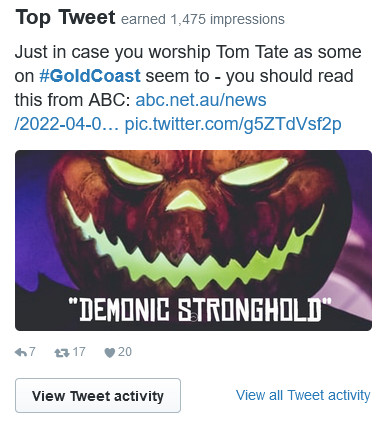
Link to your profile
In Twitter your "Real Name" (max 20 characters) does not need to be your actual name. Your Username or handle (max 15 characters) should also count. Our Twitter Username is @goldcoastlogin which is a good name for a Gold Coast based SEO and Web Developer. The bio reads -: Web Developer - Video - SEO - working hard to develop passive income with SEO. It is best to stay on topic as much as possible.
Link to your profile everywhere you can, and do so with strong keywords in the anchor text.
Note the above suggestion is related to SEO for your Twitter account. This article is focussed on generating SEO value from your Twitter account. However in SEO terms, a strong Twitter profile will add a value from a different domain (IP address) so both are valid techniques.
Twitter uses the "nofollow" tag in links (does not pass on SEO value) however Google is sophisticated in that a strong social media presence is always a benefit to SEO. The same applies to links you place in YouTube videos description, these too have value from an SEO perspective. Google wants to reward genuinely popular content.
On your website use metadata to link to your twitter profile so links of your articles and pages display properly on Twitter.
How Google measure's your activity
1 Google indexes some tweets
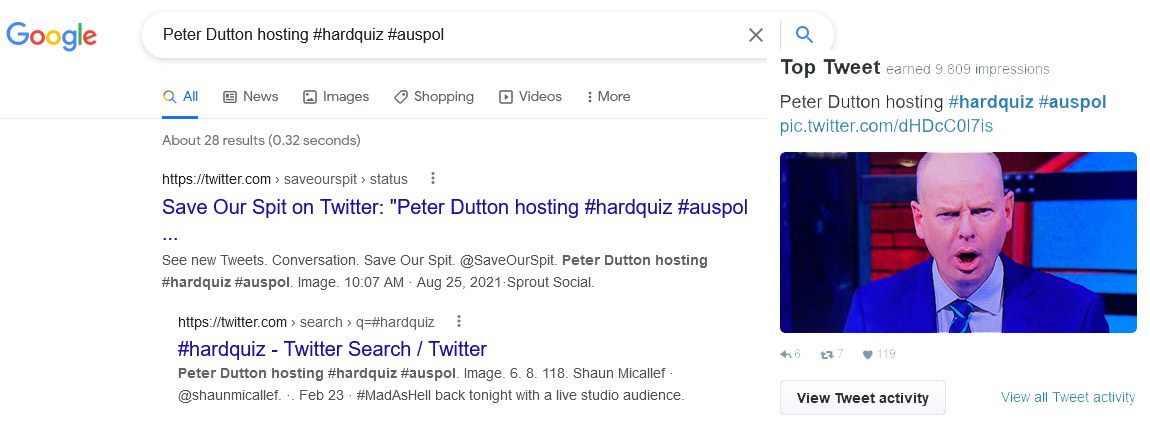
2 Google Analytics GA4 measures users and engagement from Organic Social by default-: Reports -> Acquisition -> Traffic acquisition -> Organic Social
Step 1

Step 2 Filter with Source to reveal specific clicks from Twitter (and other sources or referrals)
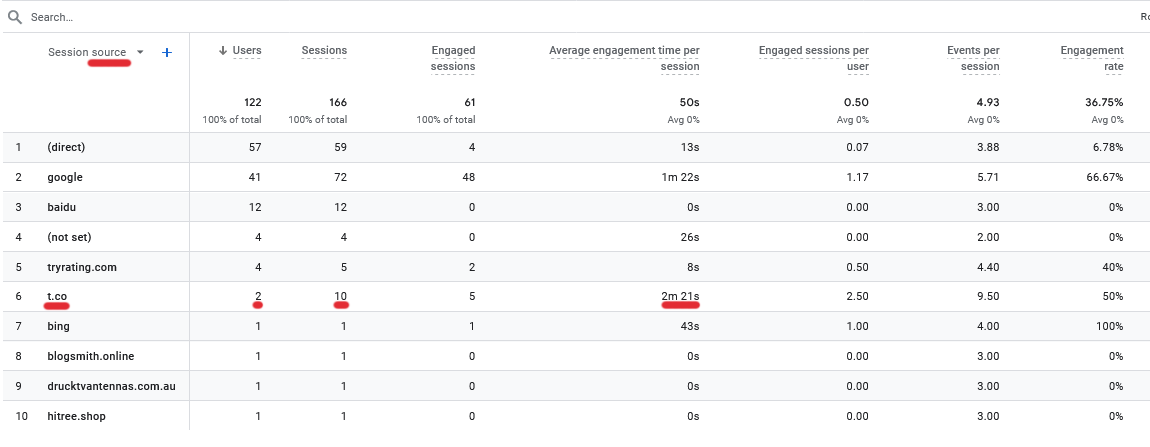
Twitter (X) provides useful analytics on post clicks and impressions. Google Analytics GA4 then gives you general data on what happens when they land on your page. Social media software like Sprout Social can give very useful reports-:
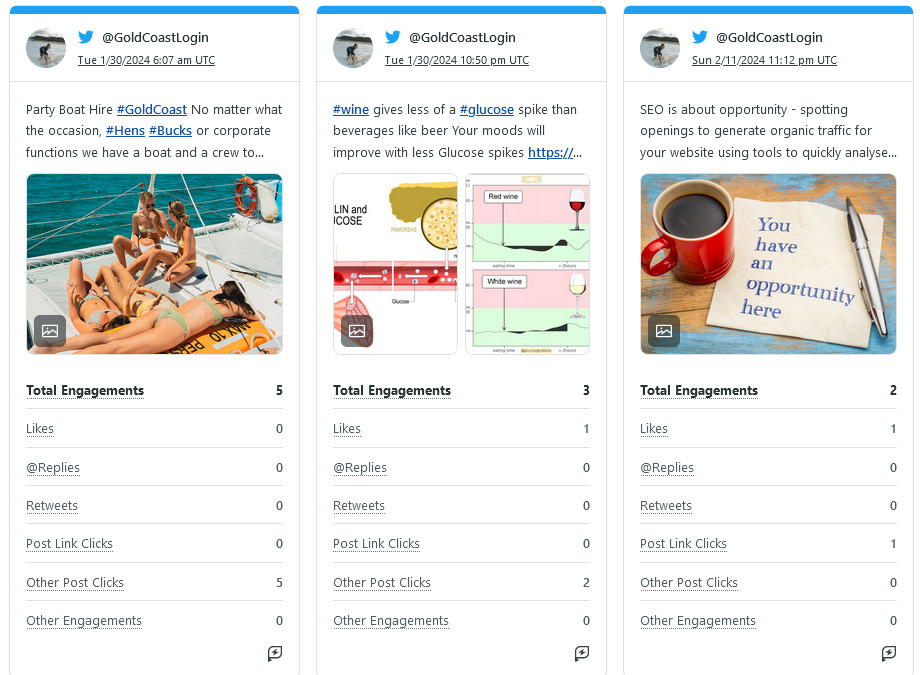
We now know which posts worked best and how the users engaged with your site.
Twitter Provides Instant Market Research
Twitter provides instant market research for your ideas. Where else can you use a hashtag that puts your information in front of everyone on the same platform? Your information can go in front of those interested in politics by using the #AusPol tag in your tweet. You can instantly test ideas and judge the response almost immediately. Then if there is a response you can expand on your idea (blog).
Twitter Images are indexed in Google Images
We created a blog about Regex for SEO and guess where the images were indexed first? From our Tweet about the article. Notice it mentions 4 days ago, and as of writing the page had not yet been indexed in Google - the tweet was.
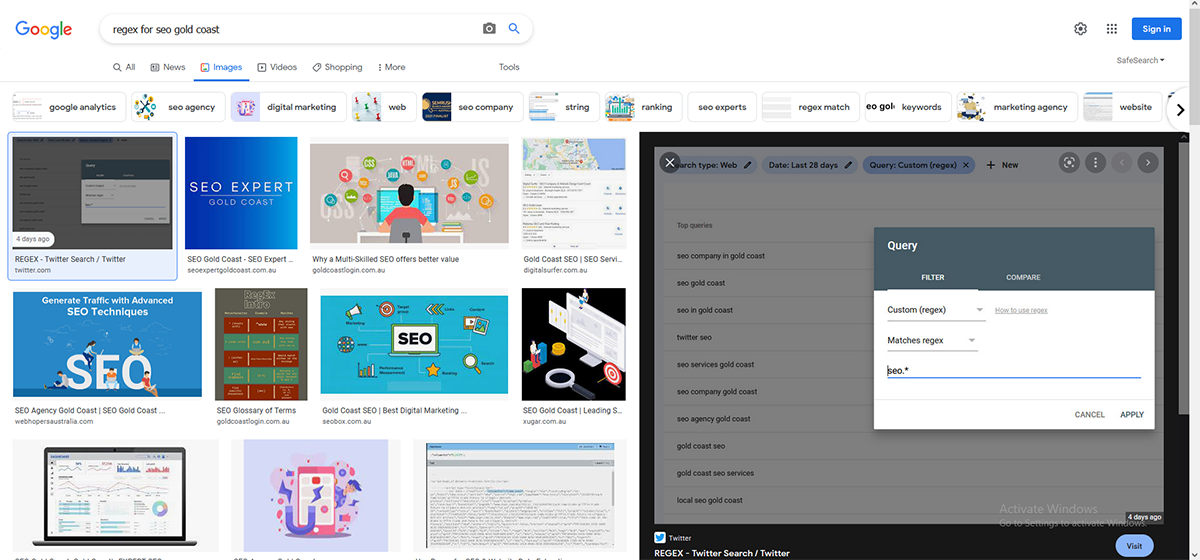
If Google can index the tweet image so quickly, should you then use a different image than is on the page? More on this when we find the answer to that.
More on this to come after further exploring the potential of Twitter "as a new wave of social and environmental activism" to generate the network effect.
Twitter's Next Chapter: Insights into the X Rebrand
Elon Musk, renowned as one of the world's wealthiest individuals, made headlines in 2022 by acquiring the widely-used social media platform Twitter. His ownership ushered in substantial changes, notably a complete rebranding, christening the platform as "X."
The shift stirred a whirlwind of emotions among users. The iconic blue bird that symbolized Twitter since its start in 2006 is no longer the face of the platform, prompting a wave of mixed reactions and an initial decline in user engagement.
However, Musk's visionary outlook for X and the rationale behind the rebranding hinted at ambitious plans for the platform's future.
Despite the initial controversy and user hesitance, X has managed to maintain its stature among the top social media platforms in 2024, albeit less dominant than Instagram, Facebook, or TikTok.
For those considering a return to X, staying informed about the changes following the rebranding is essential. Here's a guide to update you on the latest developments:
1 Name and Logo
Say goodbye to Twitter's blue bird logo. The platform now goes by a single letter: "X." This simple change sparked a backlash from users who loved the old logo and interface.
Not only does the logo change but how we talk about using Twitter is also different. Instead of "tweeting," we're now just "posting." This change affects our buttons and icons, like "tweets" and "retweets."
Elon Musk's fondness for the letter X and his vision for turning Twitter into a super app drove this sudden rebrand. He wants to expand Twitter's features beyond just news, adding payment options and TikTok-style videos.
2 X Premium
Musk's plan for Twitter focuses on moving away from ads and toward paid subscriptions. The free version of X still has the 280-character limit like Twitter, but now users can pay a premium to access long-form content.
X Premium offers three subscription tiers:
- Basic: With limited features, costs $3 per month or $32 per year.
- Premium: Costs $8 per month or $84 per year, including all useful features.
- Premium+: Costs $16 per month or $168 per year, offering a few extras beyond Premium.
These subscriptions aim to improve user experience and give users more control over how they use the platform. Here's a quick rundown on the features you are paying for in X Premium:
| Principle | Definition |
|---|---|
| Feature | Function |
| Edit Post | Enables users to edit tweets after they've been published for up to one hour. |
| Longer Post | Increases the character limit to a maximum of 25,000. |
| Prioritized Rankings in Replies | Enhances user interaction visibility. |
| Bookmark Folders and Custom App Icons | Organizes content and allows customization of app icons. |
| Blue Checkmark | Provides profile verification symbols. |
| Revenue Sharing and Creator Subscriptions | Introduces new revenue streams for a financially sustainable platform. |
| Ad Reduction | Decreases advertising frequency on the platform |
| Longer Video Uploads | Increases video upload limits. |
Consider your preferences when evaluating the usefulness of these features. While not all subscriptions may be worthwhile, if you're a content creator opting to make X your primary platform, these features could prove crucial in your decision-making process.
3The "Everything Platform"
Musk has been outspoken about his ambition to transform Twitter into the "Everything Platform," akin to China's WeChat. This concept envisions a single app encompassing virtually every online activity.
WeChat, widely used in Asian countries, is a prime example of an all-encompassing platform, offering functionalities ranging from messaging and social networking to e-commerce and financial services. Musk's vision for Twitter aligns with this model, aiming to create a comprehensive digital ecosystem that caters to users' diverse needs and activities.
The "Everything platform" is appealing because it offers convenience and efficiency. Users can access many services in one place, so they don't have to switch between different apps or platforms. Also, by combining different functions, the platform can keep users engaged and loyal to its services.
Embedding Tweets in Posts
Twitter has a tool for embedding tweets on web pages. It comes with options for display and does require a specific JavaScript to be available. Warning! A blog by default should not allow any JavaScript to be added by users.
Tradie #website misatakes #GoldCoast
— gctrades (@gctradesmen) October 8, 2024
1⃣ If you are not a web expert don't buy a website purely on the basis you could edit it.
+ lines of communication (more people involved increases lines of communication required)https://t.co/z2GvEaABoY
X Characters
X generally allows 280 characters. There are some special unicode characters allowed that take up more than 1 standard character. These characters can really enhance a tweet. Here are some examples-:
👨💻Coding
🪩Web Development
💪DSA
🌐Web3
💻Java, SpringBoot
🎨FrontEnd
🚨Backend
🧰Devops
🤖AI/ML
🦏Javascript
🏗️ Building online
📊Database
🚀UI/UX
📂Open Source
💼Freelancing
Twitter leaders in Design Consistency
Bootstrap, originally named Twitter Blueprint, was developed by Mark Otto and Jacob Thornton at Twitter as a framework to encourage consistency across internal tools.
It is free and open source and reportedly used by 19.2% of all websites. Of all the User Interface Design Principles Consistency and the instant recognition provided by icons make using the Internet easier. Bootstrap benefits UI design.
Google Realtime search deal with Twitter
Although this has not officially ended, Google's ability to crawl Twitter has been limited. Social media platforms are 'a law unto themselves'. Sometimes changing rules and APIs as they are either hacked, abused, have too many issues etc.
Developers have built apps to work with Twitter, only to find an executive decision makes that API obsolete or deprecated. A change to Twitter required people to be logged (restrictions on browsing for unregistered users) in to see content.
Social signals will remain a feature of Google.
However directly use of social signals from Twitter (like likes, shares, or follower counts) are not used as a ranking factor in search results.
Social Media Monitoring
Social media monitoring is a common practice where platforms, third-party services, and even individuals track various aspects of social media accounts for different reasons, including security, marketing, and research. It has increased in recent times. Perhaps some company's strategically monitor social media accounts to gain an advantage.
What Comes Next?
The "Everything platform" concept represents a bold vision for the future of digital engagement. It aims to streamline user experiences and meet diverse needs within a unified ecosystem by consolidating various functionalities and services into a single app or platform.
This represents a significant shift in how we interact with technology. As companies continue to innovate and integrate various functionalities into unified ecosystems, the potential for enhanced convenience, efficiency, and user engagement remains promising. The future of digital engagement is shaped by the seamless experiences offered by these comprehensive platforms.
Search News Articles...
Recent Articles

Most AI Websites Fail to Rank
- Nov 18 2025
- /
- 222

Sitemap.xml Best Practices
- Oct 14 2025
- /
- 628

Fake Reviews on Google My Business
- Oct 07 2025
- /
- 433

Sending Emails from Code
- Sep 17 2025
- /
- 536

US Tariff Shifts Undermining eCommerce
- Sep 05 2025
- /
- 655
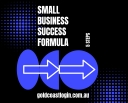
Small Business Success Formula
- Aug 23 2025
- /
- 513

Do Strong CTAs Help or Hurt Your Website?
- Jul 31 2025
- /
- 708

AI Crawlers vs Search Crawlers
- Jul 04 2025
- /
- 855

AI vs. Human Writing - How to detect Ai
- Jun 26 2025
- /
- 1262

Optimising for Brand SEO
- May 12 2025
- /
- 910
View All News Articles
Categories
A Gold Coast SEO and Web Developer